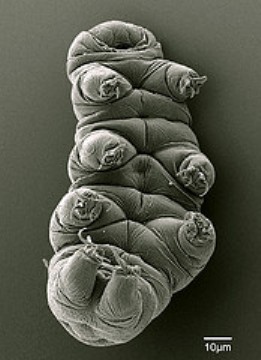
Classification
Scientific Name: Hypsibius dujardini
Common Name: Tardigrade (Water Bear)
Domain - Eukarya
Kingdom - Animalia
Phylum - Tardigrada
Class -
Eutardigrada
Order - Parachela
Family - Hypsibiidae
Genus - Hypsibius
Species - Hypsibius dujardini
Domain Eukarya: The Hypsibius dujardini is considered to be part of the domain Eukarya because its cells have a cell membrane, nuclues, among many other organelles (Eisenhour et al 2012).
Kingdom Animalia: Members of the Kingdom Animalia are multicellular organisms that are usually heterotrophic. Also most members of the kingdom Animalia ingest their food before they digest it (Eisenhour et al 2012).
Phylum Tardigrada: Members of this phylum are hydrophilous micrometazoans (Thorp et al 2010). They also have a bilaterally symmetrical body and occupy many different extreme and varying habitats (Halberg et al 2009).
Class Eutardigraga: Differentiates from other classes of tardigrades because of the absence cuticular cephalic cirri. In short these are cirri A. This class of tardigrade primarily lives in freshwater or terrestrial environments (Thorp et al 2010).
Order Parachela: Our Tardigrade falls into the order of Parachela because of the spiral structure of the buccal tube or feeding tube. This spiral structure allows these tardigrades to store more food in their buccal tube (Thorp et al 2010).
Family Hypsibiidae: The presence of interanl and external claws together is what seperates this family of tardigrades from the other 21 families in this phylum (Thorp et al 2010).
Genus Hypsibius: The Hypsibius genus of the tardigrades are freshwater and terrestrial. Also these tardigrades have a place for the insertion of muscles stylets on the anterior part of their mouth. (Thorp et al 2010)
Species Hypsibius dujardini: The species we are studying are defined by their endomesodermal pouches, this show that these tardigrades exhibit body segmentation in their embroys before they are born. This trait is unique to these tardigrades (Thorp et al 2010).